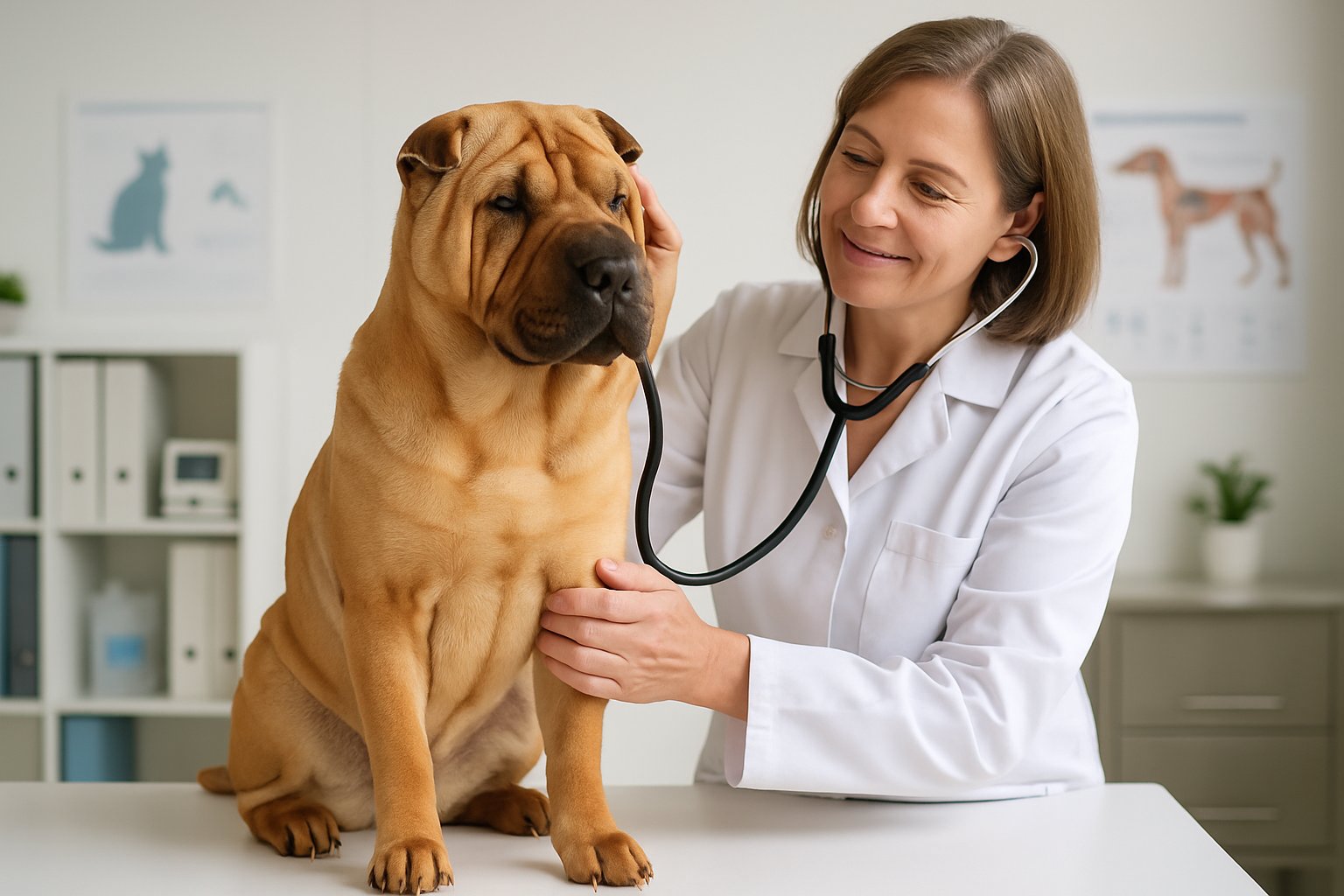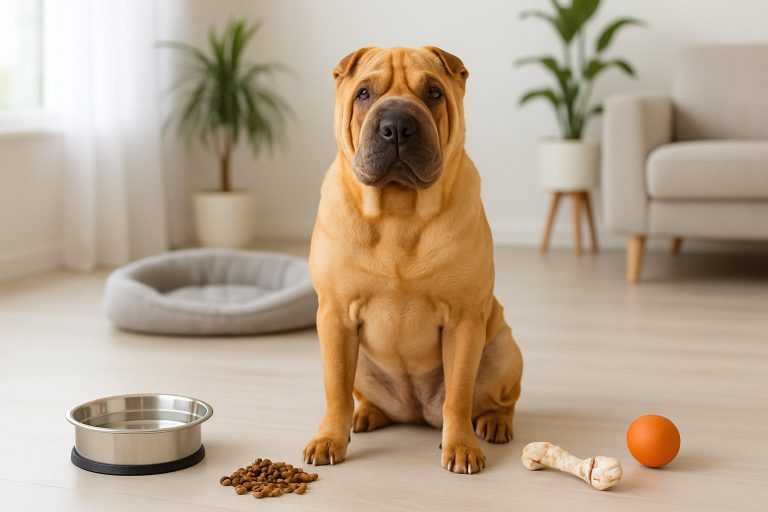Owning a Chinese Shar-Pei means taking extra steps to keep your dog healthy and happy. This unique breed is known for its deep wrinkles and strong personality, but these qualities come with special care needs. Understanding the health basics for your Shar-Pei helps you prevent common problems and enjoy more good years together.
With the right routines and knowledge, you can make sure your Shar-Pei gets the best care possible. Regular attention to health and daily habits will help your dog thrive.
1. Schedule regular vet check-ups for early detection of health issues
- Your Chinese Shar-Pei should visit the veterinarian at least once a year. Regular check-ups allow your vet to spot health issues early and help prevent serious problems from developing. Early detection can make treatment simpler and less expensive.
- Shar-Peis are known for skin problems, ear infections, and certain inherited conditions. A veterinarian can monitor your dog’s skin, ears, and joints for any early signs of trouble. This helps ensure your pet gets the right care as soon as possible.
- During a check-up, your vet may do exams, bloodwork, and vaccinations. These wellness visits are a key part of preventive care for pets. By keeping up with these appointments, you help your Shar-Pei live a healthier and longer life.
- Your veterinarian can also suggest ways to improve your dog’s daily care. These visits offer you a chance to ask questions and learn about steps you can take at home for your Shar-Pei’s health.

2. Keep skin folds clean and dry to prevent infections
- Shar-Peis have many deep wrinkles and skin folds. These areas are warm and hold moisture, which makes them more likely to get infections.
- You should gently clean your dog’s skin folds every day. Use a soft, damp cloth to wipe in between the wrinkles. Always dry the area well with a towel to stop moisture buildup.
- If you do not keep these folds clean and dry, your dog can develop rashes, yeast, or bacterial infections. These can cause redness, bad smells, and itching. Using a mild, dog-safe cleaner is helpful.
- Some people use antifungal powder for skin folds to help keep the area dry and healthy. Always check for any signs of irritation, such as swelling or sores.
- Regular care helps prevent skin problems and keeps your Shar-Pei comfortable. If you notice any changes or signs of infection, talk to your vet for advice.
3. Monitor for signs of entropion and seek veterinary care
- Entropion is a common eye problem in Chinese Shar-Peis. This condition happens when the eyelid rolls inward, causing the eyelashes to rub against the eye. It can lead to irritation, pain, and even damage to the eye surface.
- Watch for signs like excessive tearing, redness, squinting, or your dog pawing at its eyes. These symptoms may mean your Shar-Pei is uncomfortable or in pain.
- If you notice any of these signs, schedule a visit with your veterinarian right away. Prompt care can help prevent further eye damage and keep your dog comfortable.
- Treatment for entropion might include medication or a minor surgical procedure. Regular checkups and early detection are important for managing this issue and supporting your dog’s eye health.
4. Provide a balanced diet tailored to Shar-Pei needs
- Your Chinese Shar-Pei needs a balanced diet to stay healthy. This breed can be sensitive to some foods, so picking the right ingredients is important. High-quality protein should be the main part of each meal.
- Shar-Peis often have food allergies, especially to grains and some fillers. Look for diets with limited ingredients, and avoid artificial flavors or colors whenever you can. Consider foods rich in healthy fats, which help with skin and coat health.
- Include a mix of fruits and vegetables for vitamins and fiber. Fresh water should always be available. Regular meal portions based on your dog’s age, size, and activity level are key to avoiding weight problems.
- Check with your vet if you are unsure what diet is best for your Shar-Pei. They can recommend the most suitable food for your dog’s needs and health.
5. Ensure consistent exercise to avoid obesity and joint problems
- Your Chinese Shar-Pei needs regular, moderate exercise every day. This breed is prone to gaining extra weight if left inactive. Obesity can lead to joint stress and other health concerns.
- Help your dog avoid these risks by setting a daily routine. Short walks and gentle play work well for most Shar-Peis.
- Overexercising is not necessary and can sometimes strain their joints. Focus on exercises that protect their joints, such as walking and swimming. These types help reduce wear and tear on cartilage and joints. You can find more information on joint-healthy exercises.
- Stay consistent with exercise, especially as your dog ages. This helps keep your Shar-Pei at a healthy weight and supports long-term wellness.
6. Trim nails regularly to prevent cracking and discomfort
- Keeping your Chinese Shar-Pei’s nails trimmed is important for their comfort and mobility. Long nails can crack, split, or get caught on surfaces, leading to pain or infection. Trimming helps prevent these problems.
- Use clean, sharp nail clippers made for dogs. Trim only a small amount at a time to avoid cutting the quick, which is the sensitive area inside the nail. If you are unsure, ask your vet or a groomer for a demonstration.
- Regular trimming supports proper paw health and helps your dog walk normally. Shar-Peis with trimmed nails are less likely to develop nail injuries or infection. This simple grooming step is a key part of maintaining their overall nail and foot health.
- Check your dog’s nails every two to three weeks. If you hear clicking on hard floors, it’s time for a trim. Making nail care a regular habit keeps your Chinese Shar-Pei safe and comfortable.

7. Watch for symptoms of Shar-Pei Fever and act promptly
- Shar-Pei Fever is a serious condition that affects this breed. Common signs include high fever, swelling of the hocks (ankle joints), and sometimes pain or stiffness in the legs. These episodes can come on suddenly.
- If your Shar-Pei shows these symptoms, it is important to take them seriously. The fever can last from 12 to 36 hours and may recur over time. In severe cases, repeated fevers can lead to lasting damage to the kidneys or liver.
- You should contact your veterinarian right away if you notice any of these signs. Prompt care can help manage episodes and reduce the risk of long-term issues. Managing Shar-Pei Fever requires close monitoring and sometimes medication to control inflammation.
- Being aware of Shar-Pei Fever and acting quickly when symptoms appear can make a big difference for your dog’s health.
8. Brush teeth routinely to maintain dental health
- Keeping your Chinese Shar-Pei’s teeth clean is important for their health. Dental problems like tartar buildup and gum disease are common in dogs and can cause pain or lead to other serious issues if not managed.
- You should brush your Shar-Pei’s teeth regularly, at least a few times a week. Use a toothbrush and toothpaste made for dogs. Human toothpaste is not safe for pets.
- Dental care helps prevent bad breath, pain, and tooth loss. It also lowers the risk of infections that can affect other parts of your Shar-Pei’s body.
- Routine brushing can be supported by dental chews or toys, but these are not a replacement for brushing. Regular dental checkups by your veterinarian are also important for keeping your Shar-Pei’s mouth healthy. For more tips on keeping teeth and gums in good condition, visit this guide on simple dental care.


